Blog commenting
There’s also the option of using blog comments as a way to generate traffic to your site.
In the past, I have managed to generate $25,000 as a result of 249 comments.
So, how exactly do you go about using comments to generate traffic?
First, you need to find sites that are posting content related to your niche.
If you’re struggling to find sites to comment on, you can use Buzzsumo to help you find sites where relevant content is being created.
Another option is SEMrush. Input your website’s URL on its homepage to find your main organic competitors. It will then present you with industry blogs that should be a part of your blog commenting strategy.
The strategy used to find sites that accept guest posts can also help you here.
You can use a plugin called ‘Similar Sites,’ to find industry sites similar to the ones you’re already visiting.
It’s important to visit the websites and analyze the traffic, site authority, social media influence, and pageview estimates. Does the content get shared? Do people relate to the author?
I suggest using SimilarWeb to see traffic numbers, statistics, and analytics. Ideally, you’d want to comment on blogs that receive a lot of relevant comments, social shares, and pageviews.
Alternatively, you can also repeat Sujan Patel’s strategy for identifying which blogs to comment on. He perceived that blogs rankings on the first few pages of Google for his keyword searches were a good fit since they had good rankings. This also implied that they were likely to receive higher traffic.
When you’re compiling a list of blogs, ask yourself how much time you can dedicate to blog commenting.
Persistence is important, but so is getting to the comment section before anyone else.
Feedly is a great tool that notifies you when a blog posts new content. It also gives you an option to organize all of your blogs under one tab. This is especially useful if you’re dealing with several niches.
It’s worth mentioning that comments left on industry sites are going to bring you better results than blogs that are not related to your industry.
I followed this rule myself and you’ll see from the chart below that most of my comments were left on ‘industry blogs.’

The reason for this relates back to the first section in this post.
Traffic from industry blogs is much more targeted than traffic from other sites.
As a result, this kind of traffic is more likely to ‘convert’ when presented with an offer or a signup form on your site.
For instance, let’s say you provide email marketing services and your landing page talks about generating leads via email.
If you comment on The New York Times, the majority of those visitors are news readers and may not comprehend what your website is about when they get there.
By leaving comments on relevant industry blogs, you’ll gain more conversions and visibility as a result – not merely visitors.
It’s a good idea to avoid commenting on competitor blogs. This is generally out of respect.
When leaving a comment, make sure that you are adding something worthwhile to the discussion.
There is no use in leaving comments like “Awesome post!” or “Nice website!”
If someone posts a question, make sure that you take the time to answer thoughtfully.
This showcases your expertise in the given niche and will encourage someone reading to click on your name and be taken through to your site.
If you read an article on a subject you don’t know very well, it would be imprudent to voice your own thoughts as fact. In this situation, you should simply ask questions. Then the website owner would be able to elaborate more on complex topics or complicated sections.
If you’re knowledgeable about a subject, feel free to contribute (e.g., suggest something, recommend a solution, answer a question). But if you’re a novice, it’s best to ask questions. Powerful questions can bring you website traffic by encouraging blog readers to check you out.
Avoid embedding links in your comments. It comes off as a wretched attempt to plant your flag on someone’s lawn.
It’s okay to use your website’s link in the URL field when entering your name and email address, but your comment needs to add to the conversation or challenge an idea without lazy attempts at driving traffic to your blog.
Refrain from using the name of your business as your ‘commenting name.’ Use your actual full name instead.
When you attend a live exhibition, do you ever go to a potential client and start talking about your product/service without an introduction?
Of course not.
Instead, you begin by mentioning your real name and the name of your company. The other party does the same and the conversation begins. It’s a simple phenomenon, but many neglect this rule of thumb on the web.
Using a random or fake name is a missed opportunity to build strong branding, because your brand actually starts with your name. In fact, failing to use your full name will reduce your chances of the website owner approving your comment.
After a blog has published new content, they expect readers to go through, leave comments, and spread the word on social media – but more significant, they expect people to get personal with the author of the post.
Every time I comment on someone’s blog, I don’t just use my second name and skip mentioning the first. I ensure the website owner or the author of the post in question knows my full name first before reading my comment.
I do the same when responding to comments on my blog. Other commentators always see my full name.

This works because it makes you appear more personable, and it also reduces the impression that you’re just leaving a comment to promote your blog.
Try and ensure that your comment has a good ‘avatar’ too, whenever possible.
A picture of your face will work well. If you’re serious about leveraging blog comments to drive traffic to your website, consider getting a Gravatar image.
Many websites today integrate Gravatar. This way the icon beside your comment is an image of the real you, not just some generic icon that doesn’t signify your business.
Most site owner wouldn’t attribute any success with blog comments to their Avatar, but I can tell you it helps make you seem more personable.
Remember that your target audience usually hangs out on the same websites that you visit and comment on. When you look real and approachable, they’ll be more inclined to visit your website and see what you have to offer.
Social media
Social media can massively impact your business and its ability to generate traffic and sales.
According to a report by Hootsuite and We Are Social, there are 3.773 billion internet users globally. Can you guess how many from that figure are active social media users? A staggering 2.789 billion!
The massive penetration of social has made companies realize they can’t do without an active presence on Facebook, Twitter, etc.
When it comes to social media, you can’t just barge into the ‘conversation’ and ask people to buy something from you or to visit your website.
You need to provide value first and develop some goodwill between you and your potential ‘followers.’
This is why content marketing tends to work well when combined with social media.
With content marketing, you can first provide value to people who will then be encouraged to visit your site.
If your content is good enough, they’ll be persuaded to visit again, so that they can consume some of your latest content.
They’ll also be more inclined to follow you on social media, which can help drive traffic when you post content in the future.
Just because a piece of content is old doesn’t mean that it is not worth sharing.
Thanks to tools like Buffer, you can repost old content again and again so that it gets the coverage it deserves.
Here is a guide, provided by Buffer, that helps you figure out how you should go about posting your content.

If you’re worried about being seen as a spammer, here are some things to keep in mind.

One of the main reasons people are seen as spammers is because they go about posting the same message over and over again.
You can overcome this issue by describing a single piece of content in different ways for each status update.

This works well because different ‘hooks’ work for different people.
Some people connect more with status updates that include data and others are more lead by ‘curiosity’ style status updates.
But, if you want to maximize your social media reach and drive massive referral traffic, then you can’t just push out content and expect good results.
You’ve got to humanize your presence, because social media audiences desire authenticity.
Think about how you’d present your brand in real life when you meet an individual for the first time. Would you immediately talk sales in their face? How about providing details about your product/service without introducing yourself first?
Likely, that individual will form a bad first impression of you.
The same applies to social media. It’s a two-way street. Certainly, you can educate your followers with updates and blog posts about your business. But, always encourage followers to leave feedback and engage with your posts.
For every social media platform, there are certain hours in a day when people are the most active. Schedule your social media content to be published at those hours to drive higher engagement.
Use infographics, animated GIFs, and other visuals to encourage clickthroughs and social sharing.
When I researched the best forms of social media content for my blog post published on the CoSchedule blog, I found infographics are the most shared type of content. Even more than video!

The takeaway? Include data or statistics in the visuals you share on social media. It will improve the perceived value of your content and give people a good reason to visit your website.
And, don’t forget to entertain your social media audiences.

Share an image from your daily life or take your followers behind the scenes.
If you’re a corporation, then share visuals from your conferences. Or, simply share images that highlight your company culture – it’s always good to give a face to your business.
Every social platform has its own native functionality. You can create one piece of content and post it across every social network, but that may not receive a positive response and come across as lazy.
When you share an update on Snapchat, the content is expected to have a natural, raw vibe. Snapchat users particularly like seeing vertical videos of people shot through smartphones. Likewise, Instagram users like to see beautiful images.
Sure, you can write a 140-character post on Twitter, capture its screenshot, and post it on Snapchat/Instagram/Facebook.
However, that just wouldn’t attract the same level of interest from your target audience. As a content marketing strategy, it looks indifferent, even dull.
This cheat sheet, shared by Likeable Media, highlights the pros and cons of the main social media networks.

Gary Vaynerchuk is a great example of an individual that handles all social media platforms extremely well. All his updates are filled with enticing, personable, and relevant content that seems to be at one with the social network.
If you go through his Instagram profile, you’ll see many inspiring quotes with Gary himself in the background. You’ll also see candid images from his event engagements.

On Twitter, his updates are a mix of his videos, images, and real-time thoughts on events that he considers important. So, he shares just the kind of content people expect.
Even though he might be automating some content through tools, most of his social content has authentic appeal. And because authenticity is the modern day testimonial on social networks, Gary’s updates get a lot of engagement, which is key to driving referral traffic.
Another aspect you should focus on is communicating with your social media followers.
If you follow any of my social media profiles, you might have noticed that I respond to most of the questions and comments left on my posts. That’s because I value feedback from each one of you.

In addition to having a strong social media content strategy, you need to have a site structure that encourages your visitors to share your content on different platforms.
Remember the time when you had to copy a URL and manually post on social media?
That process is a real inconvenience.
By incorporating social media buttons on your website, you can eliminate the extra hoops your visitors need to jump through to share your content on their network.
When visitors click on a social media button, it automatically generates a landing page link and title of the blog post so visitors can customize it quickly and share with their audience.
I recommend ShareThis to get the job done.
As one of the most complete social sharing tools out there, you can spend a lot of time exploring ShareThis and its many features.
Chances are that some of its features will change your social media marketing approach, while helping to drive more social shares and consequently more referral traffic to your website.
By using the different approaches seen above, you’ll be able to make your content look attractive to different segments of your audience.
If you consistently provide value, you have more leeway to promote offers on your social media platforms and to generate more sales.
Q&A Websites
How many times have you typed a question or query into Google and your answer showed up on a website like Quora or Stack Exchange? We’ve all used Q&A sites at one point or another, even if we didn’t realize their immense value at the time.
That’s because these websites are like organic traffic machines. They can work wonders for getting you found online without any comprehensive or complicated SEO strategy at work in the background.
This is particularly true for Quora and Stack Exchange, which are two of the most popular Q&A sites out there. In fact, according to Alexa, Quora is the 110th most popular website in the world and the 61st most popular website in the United States.
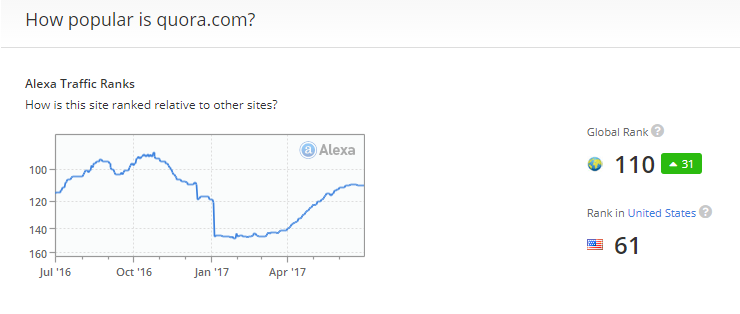
Just as with any of your digital efforts, you’ll need to approach these sites with a plan in mind for maximizing your results. Take some time to explore how they work, the types of questions you might benefit from, and how to best appeal to readers and maximize your impact.
For example, you’ll notice that Stack Exchange has a series of mini Q&A sites for different topics, many of which are devoted to education and technology. Some brands will be a perfect match, while others might want to consider more relevant techniques.
Start by identifying your best topics, search phrases, and categories.
Look for a magic formula when you’re finding the right questions to answer: the newest questions with the highest views and least answers. This is because newer questions get the most attention and have the least competition.
In your profile, fill out the “Knows About” section to show readers your areas of expertise. You can perform a search to find the right ones. Quora will suggest the most popular, and you can select them and click “Add”.
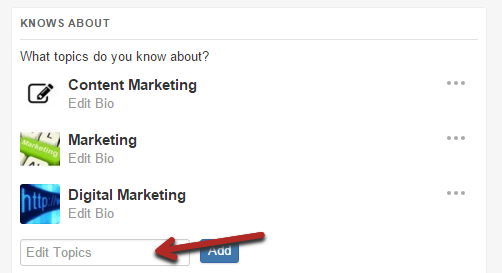
Once you’ve optimized your profile, click the “Answer” button at the top of your menu. Quora will suggest some questions for you to answer based on these.

Scroll through the questions based on time posted, the number of answers, and the number of followers… and answer away!
For Stack Exchange, the process is a bit simpler. I mentioned that it has mini sites by topic, which you can access via the top drop-down menu.
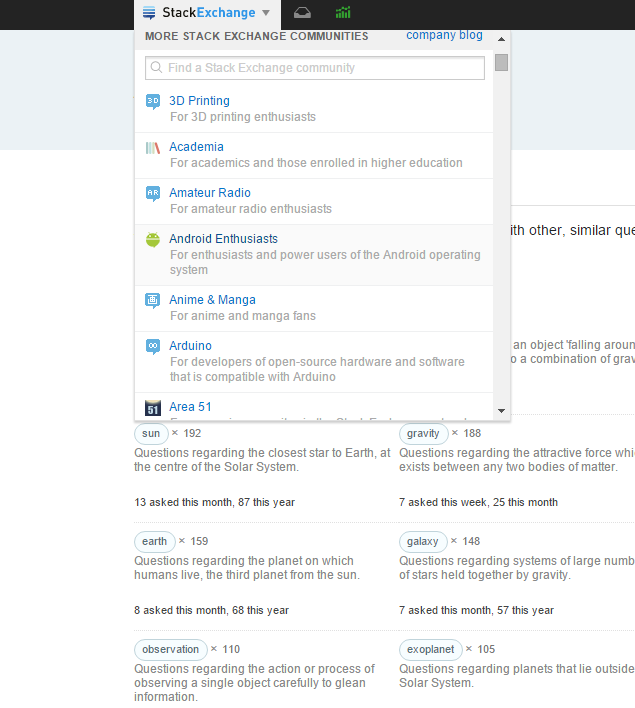
Additionally, you can sort everything on the site by tags.
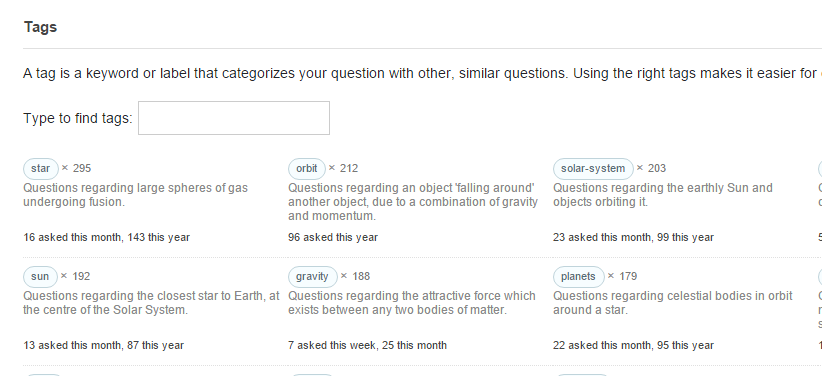
This is fairly similar to Quora, but Stack Exchange gives you a great bonus: extra filters to choose your best questions. One of my favorites is the “newest” filter, along with “votes” and “frequent”.
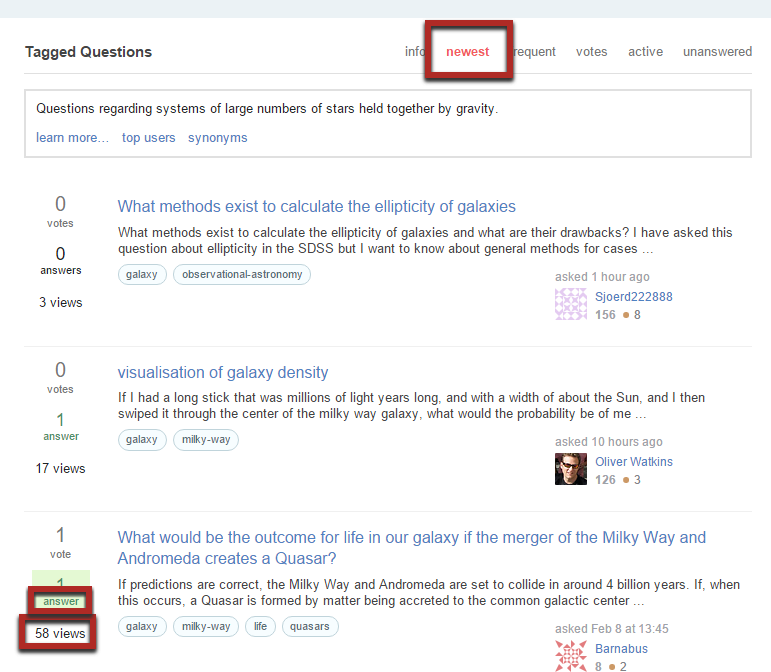
Once you’ve got your eye on the right questions to answer, don’t skimp on the effort here. Structure your answers for maximum impact.
This is truly about quality over quantity. If your answers aren’t top quality, you’re not going to get the traffic you’re hoping for.
I strongly recommend only answering questions on topics you’ve already written about, so you can provide strong answers with the ability to relevantly and naturally link readers back to your site.
Take for example one of my older Quora questions, which was perfectly related to a post I’d already written:
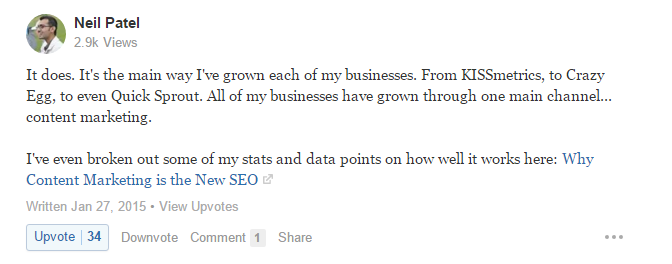
Generally speaking, there are 3 methods to shoot for. This was the short-and-sweet method.
As an alternative method, you could write a more detailed answer that still links back to your website.
In the third, bolder approach, you can go straight in for the kill and directly recommend your product or service.

It’s critical that you’re earnest and transparent and that you detail exactly why your product helps answer or solve the question. Don’t get spammy!
Remember, in order to be successful with the Q&A technique, you’ll need to be upvoted by users, so they’ll have to really get value from your answer.
As with all of your digital marketing efforts, you should absolutely be tracking your efforts to make sure you’re actually getting results.
Google Analytics is a great way to check on this. Go to Acquisition → Overview → All Traffic → Referrals.
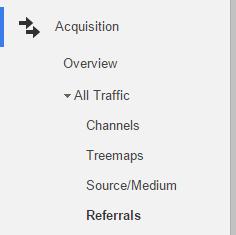
Look for the names of your Q&A sites to see how many people actually clicked the links in your answers. You’ll also be able to see other helpful stats like how long those users stayed on your site and whether they visited other pages on your site.
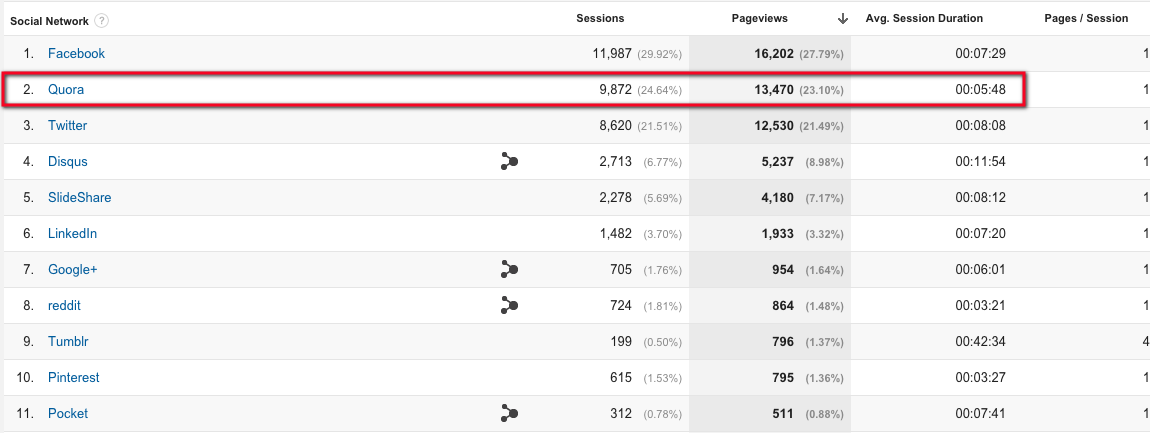
If your first 5-10 answers don’t pick up the momentum you were hoping for, don’t get discouraged. This is normal. Keep at it until you hit 20-30 questions, and that’s when you’ll really know if your efforts have been worth it and whether you should continue with this strategy.
Here are some other Q&A sites you can check out to see if it’s a good fit for your industry, goals and strategy:
The knowledge you possess as an expert in your field is the same knowledge you need to stand out on Q&A websites.
So create a profile and look for those on which you’ll build your credibility.
Conclusion
You shouldn’t only rely on search engines to generate traffic to your site.
After reading this post, you should now be familiar with the different tactics that you can use in order to get people to visit your site.
Such tactics include online advertising, social media traffic, guest posting, and commenting.
Whether you use one of these tactics in isolation, or you use all of them together – any of them can transform the way your website currently attracts visitors.
Try one the methods out and see if you can finally break away from having to rely on traffic coming from search engines alone.
What have you experienced when it comes to generating traffic without having to rely on search engines?

